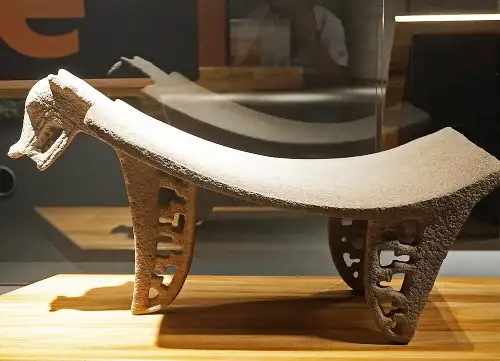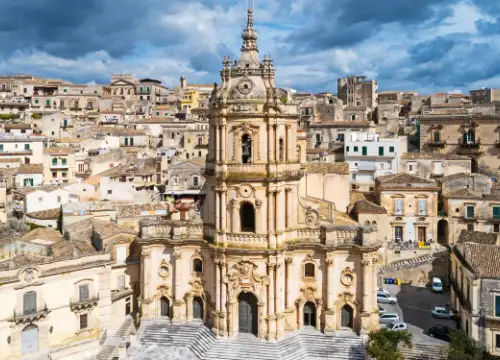Published:
Author: Antonio Maria Guerra
Modica Chocolate
THE COMPLETE GUIDE TO THE CHOCOLATE FROM THE PAST

This article is a comprehensive guide to Modica Chocolate, the sweet speciality from Sicily that is the heir to a centuries-old tradition. Let’s discover the secret of its success by examining its characteristics and the method of preparation: a particular process that gives this delicacy a unique texture and taste.

What is Modica Chocolate?
A complete guide to Cioccolato di Modica can only begin by explaining what the specialty this speciality is all about: it’s a particular type of chocolate, produced in the Sicilian town of Modica using a process characterised by a (relatively) low cocoa processing temperature. Such a method gives this delicacy a unique texture, preserving the sugar crystals inside: distinctive elements that are clearly perceptible on the palate and allow the taste to express itself to the full.
Fascinated by the Complete Guide to Modica Chocolate? You will be even more so by discovering its history in this article.
Modica: a blend of chocolate and baroque art.
Modica Chocolate comes from the town of the same name, located in the south-east of Sicily.
Read more.
A place full of charm that has become famous not only for its confectionery specialty but also for its striking urban landscape, characterized by ancient noble palaces and monumental churches that represent a true example of Baroque art. The architectural beauty of this center is such that it has earned its inclusion in the list of UNESCO Heritage Sites since 2002.

The ancient origins of Modica Chocolate.
To discover the origins of Modica chocolate we must go back to the distant past, and more precisely to the 16th century. It was then that the Spanish conquistadors, who were engaged in the ‘civilization’ of Central America, discovered that the Aztec people used the beans of a vegetable unknown in Europe, cocoa, to prepare a bitter drink (*1) ‘worthy of the gods’, called ‘xocoàtl’. They then decided to import the plant, its fruits, and the technique to the mother country, the Kingdom of Spain. From there the new specialty gradually spread throughout the Crown’s territories, including the County of Modica, in Sicily.
(More in-depth information about the History of Modica Chocolate in the article we dedicated to it)

No ‘Conching’ for Modica Chocolate.
Conching is a method used in the production of chocolate since its invention by Rodolphe Lindt in 1879. This technique, which involves stirring the product at high temperature for several hours, gives it a fine, velvety texture and enhances particular flavors.
Read more.
It should be stressed that Modica Chocolate does not make use of conching, thus preserving the original granular texture that distinguishes this specialty. (Read more in the article dedicated to the History of Modica Chocolate)

Modica chocolate: how is it made?
Beyond its undeniable charm, it is legitimate to wonder what makes Modica chocolate so special. Well, this sort of ‘secret ingredient ’ consists in its particular method of preparation, which makes use of a low-temperature processing technique whose origins are very ancient.
Click here for a detailed description of the procedure.
THE PREPARATION OF COCOA PASTE
1) Quality control: The cocoa beans, once extracted from the bags coming from the production areas, are carefully examined;
2) Removal of impurities: The beans are cleaned of any unwanted residues from their harvesting and transportation;
3) Toasting: the beans are toasted in special temperature-controlled ovens. This stage is particularly important as it helps to enhance the flavor of the cocoa produced;
4) Grinding: thanks to a special machine, the hopper, the cocoa beans are crushed and the husks are vacuumed and then discarded. Grinding the beans does not produce a powder, as one might think, but a pasty cream known as ‘cocoa paste’: this is due to the presence inside of them of a fatty substance called ‘cocoa butter’.

THE PREPARATION OF MODICA CHOCOLATE
Note: it is not uncommon for manufacturers to start processing directly from the cocoa paste.
1) Melting: the bitter cocoa paste is melted (in a bain-marie or using tempering melters), taking care to maintain a temperature of no more than 50° C.
2) Mixing: after melting, sugar and, eventually, other ingredients (such as spices, natural flavourings, dried or dehydrated fruit and salt) are added. Continuous stirring ensures the amalgamation of the components and the correct consistency.
3) Tempering: it’s then possible to proceed with tempering, which takes place at a low temperature: this preserves the grainy consistency and authentic flavour of the cocoa, giving Cioccolato di Modica its distinctive characteristics in terms of flavour and texture.
4) Portioning and ‘beating’: the mixture is poured into rectangular shapes which are then shaken (‘vibration’). This technique gives the product homogeneity, thanks to the surfacing and consequent expulsion of any air bubbles.
5) Cooling and demoulding: the chocolate bars are cooled using room temperature or in the fridge (5°/15°), then ‘sformate’ (‘demoulded’, i.e. taken out of the mould).
The tablets are finally ready to be packaged and marketed.
During the last years there has been a gradual increase in the export of this specialty throughout the world.

Modica Chocolate: the ingredients.
Cioccolato di Modica owes its deliciousness to its particular method of preparation and to the top-quality ingredients used. These ingredients are bitter cocoa paste (in a proportion of 50 to 99%) and refined or whole cane sugar (in a proportion of 50 to 1%). Optional ingredients (spices, natural flavourings, dried or dehydrated fruit, salt) can also be added to further flavour the speciality.

Modica Chocolate, the complete guide: the flavors.
Modica Chocolate, which has become famous thanks to its particular texture on the palate and a strong cocoa flavour, is available to consumers both in a ‘basic’ type (containing only cocoa paste and sugar) and in flavour varieties obtained thanks to additional ingredients used during the production. Below is a short list including some of the most popular flavourings:
Click here for the list.
- Plain darkModica Chocolate: the most classic, sold with different percentages of cocoa;
- Modica Chocolate vanilla-flavored;
- Modica Chocolate citrus-flavored;
- Modica Chocolate cinnamon-flavored;
- Modica Chocolate with Pistachio Verde di Bronte PDO;
- Cioccolato flavored with coffee;
- Cioccolato flavored with sea salt;
- Modica Chocolate Marsala wine-flavored;
The number of these varieties is constantly increasing and, from season to season, is enriched with new creations: combinations, often daring, that renew the specialty while respecting its ancient tradition.

Modica chocolate ‘with salt’.
Among the many flavors in which Modica Chocolate is marketed, the one with salt is undoubtedly one of the most interesting. In fact, its addition, which takes place during the production process, can give this confectionery specialty a surprising contrast between the sweet and savory components: something particularly appreciated by the most demanding gourmets.

Modica Chocolate, the complete guide: nutritional properties.
Among the factors that make Modica Chocolate a product of excellence, its nutritional properties must be mentioned. The typical ‘cold processing’, used to produce this specialty maintains unaltered the characteristics that make cocoa a food beneficial to health. Characteristics such as, for example, the presence of flavonoids and antioxidants (useful in preventing cardiovascular problems), as well as that of valuable minerals such as iron, magnesium, copper, and potassium. The absence of added cocoa butter, or other vegetable fats, makes Modica Chocolate much more digestible than the low-quality industrial chocolate on the market.

Modica Chocolate, the complete guide: nutritional values.
What is a complete guide to Modica Chocolate without a list of its nutritional values? Here it is their quantities (on average) in 100 grams:
- Calories: 500/550 kcal;
- Proteins: 5/8 gr.
- Carboidrates (incl. Zuccheri): 45/55 gr.
- Fats: 30/35 gr.
- Fibers: 6/10 g;
- Salt: 10/15 mg;

ChocoModica: the Modica Chocolate Festival.
The ‘Sagra del Cioccolato di Modica’ (‘Modica Chocolate Festival’) is an event that arouses great interest, especially in Italy, as evidenced by the high number of Google searches for this keyword. That’s probably why every year, at the beginning of December, a festival is held: it’s called ‘ChocoModica’. The entire historic center of the city, full of picturesque views, becomes the ideal stage for the presentation of this delicacy, giving guests the opportunity to learn more about it and meet its most traditional producers. (For more information please visit the Official Website of ChocoModica)

The events dedicated to Modica Chocolate.
Considering the growing fame of Modica Chocolate, it is not surprising that, in addition to the aforementioned ChocoModica, this specialty has become the protagonist of a large number of gastronomic events dedicated to chocolate and, more in general, to confectionery products. Festivals that take place, throughout the year, both in Italy and other countries. For those who wish not only to taste this delicacy but also to know it better and get in touch with its historical artisans, we suggest attending one (or more) of the following events:
Click here for the list.
- Eurochocolate: an international fair dedicated to chocolate held in Novemberin the Italian city of Perugia. During this event, which reached its 30th edition in 2024, Modica Chocolate is always among the guests of honor;
- Sigep (Rimini): an international ice cream and pastry fair, held every year at the end of January. It always hosts a significant representation of Modica producers;
- The Salone del Gusto in Turin: an event organized every year by Slow Food, where Modica chocolate is presented as an example of the best of Italian gastronomic tradition.

Consortium of Modica Chocolate PGI: contacts.
The ‘Consorzio del Ciocolato di Modica’, founded in 2003, brings together the most traditional producers of the specialty and is undoubtedly the most authoritative point of reference for everything related to this sweet product. We report below some useful contacts.
Contacts
Consorzio di Tutela del Cioccolato di Modica IGP.
Address: C.so Umberto I, 149
97015 Modica (RG) – ITALY
Official Website: www.cioccolatodimodica.it
Mail: info@cioccolatodimodica.it
Tel.: +39 391 7391318
Copyright information.
The images displayed in this page belong to WebFoodCulture, with the exception of:
Public Domain Images
- “Two Mixtec Kings drinking” by Mat Jones.
- Landing of Columbus by John Vanderlyn.
Creative Commons Images
- “Modica – Ragusa” by Massimo Frasson is licensed under CC BY-SA 2.0.
- “CioccolatoModicano2012-10” bu Mussklprozz is licensed under CC BY-SA 3.0.
- “Cioccolato di Modica” by Andrea Critti is licensed under CC BY 2.0.
- “Metate” by Mariordo (Mario Roberto Durán Ortiz) is licensed under CC BY 4.0.
- “Modica StGeorgeCathedral 0215” by Ludvig14 is licensed under CC BY-SA 4.0.
- “Fresh Cacao from São Tomé & Príncipe” by EverJean con licenza CC BY 2.0.
- “Ganaché de chocolate” by luisacontreras-87 is licensed under CC BY 2.0.
- “Sorting cacao beans, Dandelion, Valencia Street, the Mission, San Francisco, CA, USA” by gruntzooki is licensed under CC BY-SA 2.0.
- “File:Marzadro-Tramoggia carico vinacce.png” by Luca Marzadro e E_A_S is licensed under CC BY-SA 3.0.
- “Cacao Seeds” by giulian.frisoni con licenza CC BY 2.0.
- “Cioccolato Modicano” by Coralie Ferreira is licensed under CC BY 2.0.
- “Salt-(sea)_B130623” by SoraZG is licensed under CC BY 2.0.
- “cocoa seeds” by lolay is licensed under CC BY 2.0.





